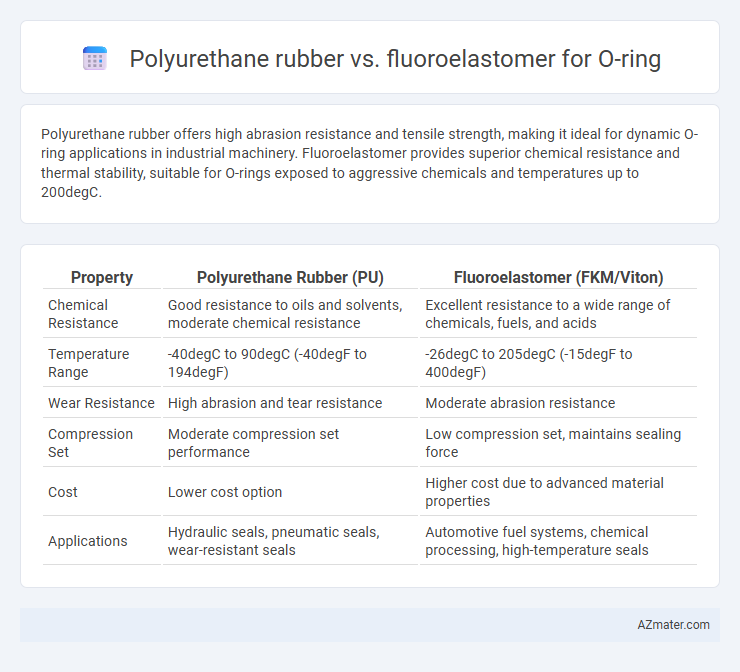Polyurethane rubber offers high abrasion resistance and tensile strength, making it ideal for dynamic O-ring applications in industrial machinery. Fluoroelastomer provides superior chemical resistance and thermal stability, suitable for O-rings exposed to aggressive chemicals and temperatures up to 200degC.
Table of Comparison
| Property | Polyurethane Rubber (PU) | Fluoroelastomer (FKM/Viton) |
|---|---|---|
| Chemical Resistance | Good resistance to oils and solvents, moderate chemical resistance | Excellent resistance to a wide range of chemicals, fuels, and acids |
| Temperature Range | -40degC to 90degC (-40degF to 194degF) | -26degC to 205degC (-15degF to 400degF) |
| Wear Resistance | High abrasion and tear resistance | Moderate abrasion resistance |
| Compression Set | Moderate compression set performance | Low compression set, maintains sealing force |
| Cost | Lower cost option | Higher cost due to advanced material properties |
| Applications | Hydraulic seals, pneumatic seals, wear-resistant seals | Automotive fuel systems, chemical processing, high-temperature seals |
Introduction to O-Ring Materials
Polyurethane rubber offers excellent abrasion resistance and high tensile strength for O-ring applications requiring durability in dynamic environments. Fluoroelastomers provide superior chemical resistance and thermal stability, making them ideal for O-rings exposed to harsh chemicals and extreme temperatures. Selecting the appropriate material depends on application-specific factors such as fluid compatibility, temperature range, and mechanical stress.
Polyurethane Rubber: Key Properties
Polyurethane rubber offers superior abrasion resistance, high tensile strength, and excellent elasticity, making it ideal for O-rings subjected to dynamic stresses and abrasive environments. Its excellent resistance to oils, greases, and hydraulic fluids enhances durability and performance in industrial applications. Polyurethane O-rings maintain flexibility across a wide temperature range (-40degC to 90degC), providing reliable sealing under varying operational conditions.
Fluoroelastomer: Key Properties
Fluoroelastomer O-rings exhibit exceptional chemical resistance, withstanding aggressive fuels, oils, and solvents, making them ideal for harsh industrial environments. Their high-temperature tolerance, typically up to 250degC (482degF), surpasses polyurethane rubber's lower thermal limits, ensuring reliable sealing performance under extreme heat. Fluoroelastomers also provide superior resistance to ozone, weathering, and aging, extending O-ring service life in aerospace, automotive, and chemical processing applications.
Chemical Resistance Comparison
Fluoroelastomer O-rings exhibit superior chemical resistance compared to polyurethane rubber, with exceptional stability against hydrocarbons, oils, fuels, and aggressive solvents. Polyurethane rubber offers good resistance to abrasion and mechanical wear but degrades faster when exposed to strong acids, alkalis, and aromatic hydrocarbons. Selecting fluoroelastomer ensures longer service life in harsh chemical environments, making it ideal for applications involving aggressive fluids and high temperatures.
Temperature Range Performance
Polyurethane rubber O-rings perform optimally within a temperature range of -40degC to 80degC, offering excellent abrasion resistance but limited high-temperature stability. Fluoroelastomer O-rings withstand a broader temperature spectrum, from -26degC up to 205degC, maintaining chemical resistance and elasticity under extreme thermal conditions. Choosing between these materials depends on the specific application's temperature demands and chemical exposure.
Abrasion and Wear Resistance
Polyurethane rubber O-rings exhibit superior abrasion and wear resistance due to their high tensile strength and excellent toughness, making them ideal for applications involving dynamic sealing under mechanical stress. Fluoroelastomer O-rings, while offering exceptional chemical and temperature resistance, generally show lower abrasion resistance compared to polyurethane, especially in environments with continuous friction or abrasive particles. Selecting polyurethane enhances durability in abrasive conditions, whereas fluoroelastomers prioritize chemical stability over wear performance.
Compression Set and Longevity
Polyurethane rubber O-rings exhibit excellent resistance to wear and tear but tend to have a higher compression set compared to fluoroelastomer O-rings, which maintain their shape and sealing capabilities better over prolonged periods under compression. Fluoroelastomer O-rings offer superior chemical resistance and thermal stability, contributing to enhanced longevity in harsh environments, often outperforming polyurethane in applications requiring sustained sealing performance. Choosing fluoroelastomer for O-rings is ideal for high-temperature and chemically aggressive conditions where low compression set and long service life are critical.
Cost Differences and Availability
Polyurethane rubber O-rings offer lower material costs and are widely available due to their extensive industrial use and simple manufacturing processes. Fluoroelastomer O-rings, known for superior chemical resistance and high-temperature performance, typically command higher prices and limited availability, especially in specialized grades. Cost differences are influenced by raw material prices and production complexity, making polyurethane a cost-effective choice for general applications, while fluoroelastomers are preferred in demanding environments despite their premium cost and lower availability.
Typical Applications by Industry
Polyurethane O-rings excel in industrial machinery, automotive, and hydraulic systems due to their exceptional abrasion resistance, high tensile strength, and flexibility, making them ideal for dynamic sealing in heavy-duty environments. Fluoroelastomer O-rings are preferred in chemical processing, aerospace, and fuel systems for their outstanding chemical resistance, high-temperature tolerance up to 200degC, and durability against aggressive fluids like oils, acids, and solvents. Selection between polyurethane and fluoroelastomer O-rings depends largely on operational conditions, with polyurethane favored for mechanical stress and fluoroelastomers for extreme chemical exposure and thermal stability.
Choosing the Right O-Ring Material
Polyurethane rubber offers excellent abrasion resistance and high tensile strength, making it ideal for dynamic sealing applications where durability is critical. Fluoroelastomer O-rings provide superior chemical resistance and thermal stability, sustaining performance in harsh environments with exposure to fuels, oils, and extreme temperatures. Selecting the right O-ring material depends on application-specific factors such as temperature range, chemical exposure, and mechanical stress to ensure optimal sealing performance and longevity.

Infographic: Polyurethane rubber vs Fluoroelastomer for O-ring
 azmater.com
azmater.com